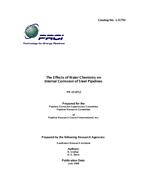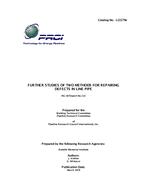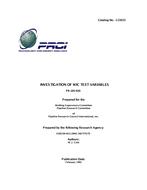Provide PDF Format
PRCI PR-15-9712
- Effects of Water Chemistry on Internal Corrosion of Steel Pipelines
- Report / Survey by Pipeline Research Council International, 07/01/2000
- Publisher: PRCI
$173.00$345.00
L51793e
Southwest Research Institute
Need: The ability to safely transport wet, untreated natural gases through pipelines offshore or at other inaccessible locations is an important factor in the development of new gas fields. The internal corrosion rate of steel pipelines varies in a complex way with the gas composition, specifically CO2 , O2 , and H2 S, and condensed water chemistry. Estimating the corrosion rate of steel at inaccessible locations from the analysis of the gas and water composition from an accessible location will enable a better determination of the need for corrosion inhibitors. Quantitative understanding of the corrosion rate of steel under these conditions will be key to an accurate risk assessment of pipelines from internal corrosion.
Benefit: Previous work conducted by Southwest Research Institute (SwRI) under the project PR 15-9313 examined the effects of gas composition and slow liquid flow conditions on corrosion of steel. A parametric equation was developed that essentially reflected the deleterious effects of CO2 and O2 , and the beneficial effect of H2S on corrosion (Lyle, 1997). While this study provided important information regarding the deleterious effect of oxygen in the gas phase, the effects of condensed water composition, especially scale-forming species such as calcium and magnesium, were not examined. Furthermore, a better thermodynamic and kinetic understanding of the effects of the gas and liquid phase composition was needed. The present project, while an extension of the previous project, breaks important new ground: (i) the water chemistry typically found in pipelines is included in the tests; (ii) the scale and corrosion product formation is examined using a thermodynamic speciation software; (iii) surface analysis of the corroded samples is performed using laser Raman spectroscopy in order to confirm the thermodynamic model prediction; and (iv) electrochemical tests are conducted to understand the corrosion kinetics. A discussion of the general literature on internal corrosion is presented in the next section, followed by a summary of results from previous SwRI projects in this area. The thermodynamic approach and results are presented in Chapter 2. The experimental results are presented in Chapters 3 and 4, respectively, along with a discussion of the results in terms of thermodynamic and kinetic framework. Chapter 5 summarizes the results of this project and provides recommendations for further investigations. Details of the thermodynamic calculations, electrochemical experimental results, and analyses of the corrosion products are presented in the appendices.
Result: The results of the laboratory study of internal corrosion in wet gas pipelines indicate that, under buffered conditions, the corrosion rate is not affected by calcium and magnesium scale-forming tendency of the test solutions. This is corroborated by field coupon data that showed no particular correlation of corrosion rate with Ca and Mg scaling tendency of the analyzed condensate water. It is possible that, under both laboratory and field conditions, the scales formed are sufficiently porous to permit electrolyte contact with steel. On the other hand, increase in pH and decrease in oxygen resulted in significant reduction in corrosion rate. Thermodynamic analysis is a valuable tool for analyzing the results of corrosion tests under diverse environmental conditions. Thermodynamic analysis indicates that the effect of oxygen on corrosion may be related to the transformation of mackinawite to greigite, which results in a volume change causing film breakage. Electrochemical polarization curves indicate that the effect of oxygen may be related to the increase in corrosion potential. Surface analysis by Raman spectroscopy confirmed some of the thermodynamic predictions of stable phases.
Southwest Research Institute
Need: The ability to safely transport wet, untreated natural gases through pipelines offshore or at other inaccessible locations is an important factor in the development of new gas fields. The internal corrosion rate of steel pipelines varies in a complex way with the gas composition, specifically CO2 , O2 , and H2 S, and condensed water chemistry. Estimating the corrosion rate of steel at inaccessible locations from the analysis of the gas and water composition from an accessible location will enable a better determination of the need for corrosion inhibitors. Quantitative understanding of the corrosion rate of steel under these conditions will be key to an accurate risk assessment of pipelines from internal corrosion.
Benefit: Previous work conducted by Southwest Research Institute (SwRI) under the project PR 15-9313 examined the effects of gas composition and slow liquid flow conditions on corrosion of steel. A parametric equation was developed that essentially reflected the deleterious effects of CO2 and O2 , and the beneficial effect of H2S on corrosion (Lyle, 1997). While this study provided important information regarding the deleterious effect of oxygen in the gas phase, the effects of condensed water composition, especially scale-forming species such as calcium and magnesium, were not examined. Furthermore, a better thermodynamic and kinetic understanding of the effects of the gas and liquid phase composition was needed. The present project, while an extension of the previous project, breaks important new ground: (i) the water chemistry typically found in pipelines is included in the tests; (ii) the scale and corrosion product formation is examined using a thermodynamic speciation software; (iii) surface analysis of the corroded samples is performed using laser Raman spectroscopy in order to confirm the thermodynamic model prediction; and (iv) electrochemical tests are conducted to understand the corrosion kinetics. A discussion of the general literature on internal corrosion is presented in the next section, followed by a summary of results from previous SwRI projects in this area. The thermodynamic approach and results are presented in Chapter 2. The experimental results are presented in Chapters 3 and 4, respectively, along with a discussion of the results in terms of thermodynamic and kinetic framework. Chapter 5 summarizes the results of this project and provides recommendations for further investigations. Details of the thermodynamic calculations, electrochemical experimental results, and analyses of the corrosion products are presented in the appendices.
Result: The results of the laboratory study of internal corrosion in wet gas pipelines indicate that, under buffered conditions, the corrosion rate is not affected by calcium and magnesium scale-forming tendency of the test solutions. This is corroborated by field coupon data that showed no particular correlation of corrosion rate with Ca and Mg scaling tendency of the analyzed condensate water. It is possible that, under both laboratory and field conditions, the scales formed are sufficiently porous to permit electrolyte contact with steel. On the other hand, increase in pH and decrease in oxygen resulted in significant reduction in corrosion rate. Thermodynamic analysis is a valuable tool for analyzing the results of corrosion tests under diverse environmental conditions. Thermodynamic analysis indicates that the effect of oxygen on corrosion may be related to the transformation of mackinawite to greigite, which results in a volume change causing film breakage. Electrochemical polarization curves indicate that the effect of oxygen may be related to the increase in corrosion potential. Surface analysis by Raman spectroscopy confirmed some of the thermodynamic predictions of stable phases.
Related Products
PRCI L52292e
Guidelines for Constructing Natural Gas and Liquid Hydrocarbon Pipelines Through Areas Prone To Land..
$6.00 $12.00
PRCI PR-91-68
Forces Acting on Unburied Offshore Pipelines -- Determination of the Adequacy of Engineering Data to..
$6.00 $12.00




